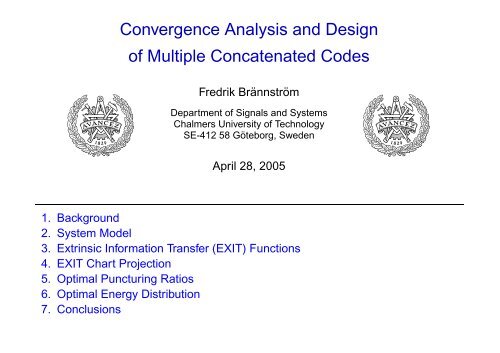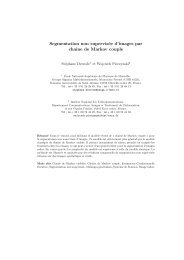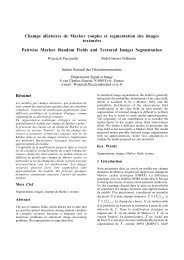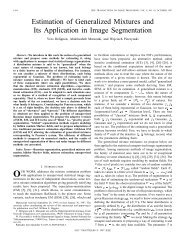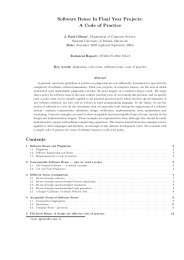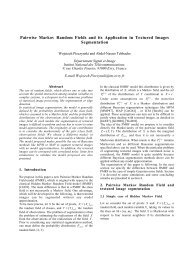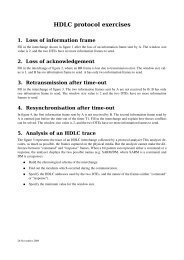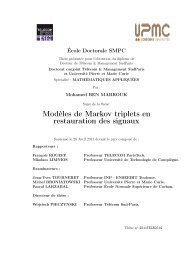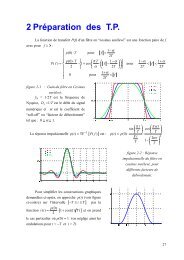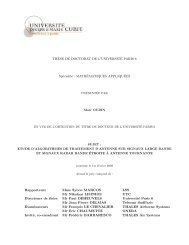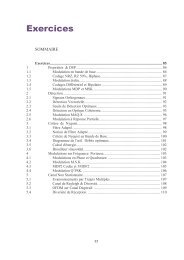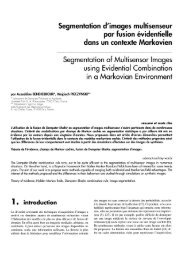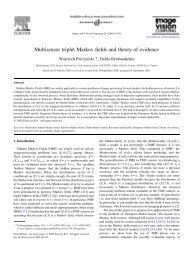Convergence Analysis and Design of Multiple Concatenated Codes
Convergence Analysis and Design of Multiple Concatenated Codes
Convergence Analysis and Design of Multiple Concatenated Codes
You also want an ePaper? Increase the reach of your titles
YUMPU automatically turns print PDFs into web optimized ePapers that Google loves.
<strong>Convergence</strong> <strong>Analysis</strong> <strong>and</strong> <strong>Design</strong><br />
<strong>of</strong> <strong>Multiple</strong> <strong>Concatenated</strong> <strong>Codes</strong><br />
Fredrik Brännström<br />
Department <strong>of</strong> Signals <strong>and</strong> Systems<br />
Chalmers University <strong>of</strong> Technology<br />
SE-412 58 Göteborg, Sweden<br />
April 28, 2005<br />
1. Background<br />
2. System Model<br />
3. Extrinsic Information Transfer (EXIT) Functions<br />
4. EXIT Chart Projection<br />
5. Optimal Puncturing Ratios<br />
6. Optimal Energy Distribution<br />
7. Conclusions
Background<br />
<strong>Concatenated</strong> codes <strong>and</strong> iterative decoding<br />
• Original turbo code by Berrou, Glavieux, <strong>and</strong> Thitimajshima (BGT) (1993).<br />
• BGT: two punctured convolutional codes concatenated in parallel.<br />
• Performance close to capacity.<br />
EXIT charts for convergence analysis <strong>of</strong> iterative decoding<br />
• Two serially/parallel concatenated codes by ten Brink in (1999, 2000).<br />
• <strong>Multiple</strong> concatenated codes (MCCs) with N = 3 components in (2001, 2002).<br />
This presentation:<br />
• <strong>Multiple</strong> parallel concatenated codes (MPCCs).<br />
• <strong>Convergence</strong> analysis using projected EXIT charts.<br />
• Optimal puncturing ratios.<br />
• Optimal energy distribution.<br />
<strong>Convergence</strong> <strong>Analysis</strong> <strong>and</strong> <strong>Design</strong> <strong>of</strong> <strong>Multiple</strong> <strong>Concatenated</strong> <strong>Codes</strong>, Fredrik Brännström 2005 1
System Model<br />
x ✲ π 0<br />
✲ π 1<br />
✲ π 2<br />
✲ π 3<br />
x 0 y 0 ✲<br />
z<br />
U 0 ✲ 0<br />
x 1 y<br />
✲ 1<br />
C<br />
✲ 1 U 1<br />
x 2 y<br />
✲ 2<br />
C<br />
✲ 2 U 2<br />
x 3 y<br />
✲ 3<br />
C<br />
✲ 3 U 3<br />
❅<br />
z 1 ✲<br />
z 2 ✲<br />
z 3<br />
❅<br />
❅<br />
❅<br />
M<br />
<br />
✲<br />
<br />
<br />
w<br />
<br />
<br />
<br />
<br />
s✲<br />
✓✏ ❄<br />
r ✲<br />
✒✑ M −1<br />
Punctured Parallel <strong>Concatenated</strong> Code<br />
❅<br />
❅<br />
❅<br />
❅<br />
E(z 0 ) U<br />
−1<br />
✲<br />
0<br />
E(z 1 )<br />
✲ U<br />
−1<br />
1<br />
E(z 2 )<br />
✲ U<br />
−1<br />
2<br />
E(z 3 )<br />
✲ U<br />
−1<br />
3<br />
A(y 0 )<br />
A(y 1 )<br />
✲<br />
A(y 2 )<br />
✲<br />
A(y 3 )<br />
✲<br />
C −1<br />
1<br />
C −1<br />
2<br />
C −1<br />
3<br />
E(x 0 ) π<br />
−1<br />
✲<br />
0<br />
E 0 (x)<br />
✲<br />
E(x 1 )<br />
✲ π<br />
−1<br />
E 1 (x)<br />
✲<br />
A(x<br />
1<br />
✛<br />
1) A π1 ✛<br />
1(x)<br />
E(x 2 )<br />
✲ π<br />
−1<br />
E 2 (x)<br />
✲<br />
A(x<br />
2<br />
✛<br />
2) A π2 ✛<br />
2(x)<br />
E(x 3 )<br />
✲ π<br />
−1<br />
E 3 (x)<br />
✲<br />
A(x<br />
3<br />
✛<br />
3) A π3 ✛<br />
3(x)<br />
• Convolutional code (CC) C n , with code rate R n , maps the interleaved source<br />
bits x n ∈ {−1, +1} L to y n = C(x n ) ∈ {−1, +1} L , for n = 1, 2, 3.<br />
• U n denotes a r<strong>and</strong>om puncturer with puncturing ratio 0 ≤ δ n ≤ 1, n = 0, 1, 2, 3.<br />
• δ n = 0.2 means that only 20% <strong>of</strong> y n is kept in z n <strong>and</strong> 80% is punctured.<br />
<strong>Convergence</strong> <strong>Analysis</strong> <strong>and</strong> <strong>Design</strong> <strong>of</strong> <strong>Multiple</strong> <strong>Concatenated</strong> <strong>Codes</strong>, Fredrik Brännström 2005 2
System Model<br />
x ✲ π 0<br />
✲ π 1<br />
✲ π 2<br />
✲ π 3<br />
x 0 y 0 ✲<br />
z<br />
U 0 ✲ 0<br />
x 1 y<br />
✲ 1<br />
C<br />
✲ 1 U 1<br />
x 2 y<br />
✲ 2<br />
C<br />
✲ 2 U 2<br />
x 3 y<br />
✲ 3<br />
C<br />
✲ 3 U 3<br />
❅<br />
z 1 ✲<br />
z 2 ✲<br />
z 3<br />
❅<br />
❅<br />
❅<br />
M<br />
<br />
✲<br />
<br />
<br />
w<br />
<br />
<br />
<br />
<br />
s✲<br />
✓✏ ❄<br />
r ✲<br />
✒✑ M −1<br />
• Code rates: R = [R 0 , R 1 , . . . , R N ].<br />
❅<br />
❅<br />
❅<br />
❅<br />
• Puncturing ratios: ∆ = [δ 0 , δ 1 , . . . , δ N ].<br />
E(z 0 ) U<br />
−1<br />
✲<br />
0<br />
E(z 1 )<br />
✲ U<br />
−1<br />
1<br />
E(z 2 )<br />
✲ U<br />
−1<br />
2<br />
E(z 3 )<br />
✲ U<br />
−1<br />
3<br />
A(y 0 )<br />
A(y 1 )<br />
✲<br />
A(y 2 )<br />
✲<br />
A(y 3 )<br />
✲<br />
C −1<br />
1<br />
C −1<br />
2<br />
C −1<br />
3<br />
E(x 0 ) π<br />
−1<br />
✲<br />
0<br />
E 0 (x)<br />
✲<br />
E(x 1 )<br />
✲ π<br />
−1<br />
E 1 (x)<br />
✲<br />
A(x<br />
1<br />
✛<br />
1) A π1 ✛<br />
1(x)<br />
E(x 2 )<br />
✲ π<br />
−1<br />
E 2 (x)<br />
✲<br />
A(x<br />
2<br />
✛<br />
2) A π2 ✛<br />
2(x)<br />
E(x 3 )<br />
✲ π<br />
−1<br />
E 3 (x)<br />
✲<br />
A(x<br />
3<br />
✛<br />
3) A π3 ✛<br />
3(x)<br />
• Energy distribution: Ψ = [ψ 0 , ψ 1 , . . . , ψ N ].<br />
• Uniform energy distribution: Ψ 0 = [ 1<br />
N+1 , 1<br />
N+1 , . . . , 1<br />
N+1<br />
• SNR for component n: γ s,n =<br />
ψ n<br />
∑ Nj=0 δ j<br />
R j<br />
ψ j<br />
γ b .<br />
<strong>Convergence</strong> <strong>Analysis</strong> <strong>and</strong> <strong>Design</strong> <strong>of</strong> <strong>Multiple</strong> <strong>Concatenated</strong> <strong>Codes</strong>, Fredrik Brännström 2005 3<br />
]<br />
.
System Model<br />
x ✲ π 0<br />
✲ π 1<br />
✲ π 2<br />
✲ π 3<br />
x 0 y 0 ✲<br />
z<br />
U 0 ✲ 0<br />
x 1 y<br />
✲ 1<br />
C<br />
✲ 1 U 1<br />
x 2 y<br />
✲ 2<br />
C<br />
✲ 2 U 2<br />
x 3 y<br />
✲ 3<br />
C<br />
✲ 3 U 3<br />
❅<br />
z 1 ✲<br />
z 2 ✲<br />
z 3<br />
❅<br />
❅<br />
❅<br />
M<br />
<br />
✲<br />
<br />
<br />
w<br />
<br />
<br />
<br />
<br />
s✲<br />
✓✏ ❄<br />
r ✲<br />
✒✑ M −1<br />
❅<br />
❅<br />
❅<br />
❅<br />
E(z 0 ) U<br />
−1<br />
✲<br />
0<br />
E(z 1 )<br />
✲ U<br />
−1<br />
1<br />
E(z 2 )<br />
✲ U<br />
−1<br />
2<br />
E(z 3 )<br />
✲ U<br />
−1<br />
3<br />
A(y 0 )<br />
A(y 1 )<br />
✲<br />
A(y 2 )<br />
✲<br />
A(y 3 )<br />
✲<br />
C −1<br />
1<br />
C −1<br />
2<br />
C −1<br />
3<br />
E(x 0 ) π<br />
−1<br />
✲<br />
0<br />
E 0 (x)<br />
✲<br />
E(x 1 )<br />
✲ π<br />
−1<br />
E 1 (x)<br />
✲<br />
A(x<br />
1<br />
✛<br />
1) A π1 ✛<br />
1(x)<br />
E(x 2 )<br />
✲ π<br />
−1<br />
E 2 (x)<br />
✲<br />
A(x<br />
2<br />
✛<br />
2) A π2 ✛<br />
2(x)<br />
E(x 3 )<br />
✲ π<br />
−1<br />
E 3 (x)<br />
✲<br />
A(x<br />
3<br />
✛<br />
3) A π3 ✛<br />
3(x)<br />
Iterative Decoding<br />
• The decoders are activated successively while passing reliability values <strong>of</strong> the<br />
bits between each other.<br />
• Decision statistics for the source bits: D(x) = E 0 (x) + E 1 (x) + E 2 (x) + E 3 (x),<br />
D(x(i)) ˆx(i)=+1<br />
≷ 0, for all i = 1, 2, . . . , L.<br />
ˆx(i)=−1<br />
<strong>Convergence</strong> <strong>Analysis</strong> <strong>and</strong> <strong>Design</strong> <strong>of</strong> <strong>Multiple</strong> <strong>Concatenated</strong> <strong>Codes</strong>, Fredrik Brännström 2005 4
Extrinsic Information Transfer (EXIT) Function<br />
x(i)<br />
✲<br />
❥<br />
✻<br />
<br />
✲<br />
D<br />
✲<br />
❄<br />
❥✛<br />
D<br />
y(i)<br />
✲<br />
x(i)<br />
✲<br />
❥<br />
✻<br />
<br />
✲<br />
D<br />
✲<br />
❥<br />
✻<br />
✲<br />
D<br />
✲<br />
❥<br />
✻<br />
<br />
y(i)<br />
✲<br />
(I A(x) , I A(y)<br />
)<br />
I E(x) = Tx<br />
1<br />
0.8<br />
0.6<br />
0.4<br />
0.2<br />
1 0<br />
0.8<br />
0.6<br />
I A(y)<br />
0.4<br />
0.2<br />
0<br />
0<br />
0.2<br />
0.4<br />
0.8<br />
0.6<br />
I A(x)<br />
(I A(x) , I A(y)<br />
)<br />
1<br />
I E(x) = Tx<br />
1<br />
0.8<br />
0.6<br />
0.4<br />
0.2<br />
1 0<br />
0.8<br />
0.6<br />
I A(y)<br />
0.4<br />
0.2<br />
0<br />
0<br />
0.2<br />
0.4<br />
0.8<br />
0.6<br />
I A(x)<br />
1<br />
EXIT function for CC(4/7).<br />
EXIT function for CC(7/5).<br />
<strong>Convergence</strong> <strong>Analysis</strong> <strong>and</strong> <strong>Design</strong> <strong>of</strong> <strong>Multiple</strong> <strong>Concatenated</strong> <strong>Codes</strong>, Fredrik Brännström 2005 5
Extrinsic Information Transfer (EXIT) Function<br />
)<br />
(<br />
I A(x 1) , I A(y1)<br />
)<br />
I E(x 1) = T x1<br />
1<br />
0.8<br />
0.6<br />
0.4<br />
0.2<br />
(<br />
1 0<br />
1 0<br />
0.8<br />
1 0.8<br />
0.6<br />
0.8<br />
0.6<br />
0.8<br />
0.4<br />
0.6<br />
I 0.2<br />
0.4<br />
0.4<br />
0.6<br />
0.4<br />
A(y1 ) 0.2<br />
I 0.2<br />
0 0 I A(y2 ) 0.2<br />
A(x1 ) 0 0 I A(x2 )<br />
⎛ ⎛<br />
⎛ ⎛<br />
√<br />
⎞⎞<br />
⎞<br />
2<br />
⎛<br />
I E(xn ) = T xn ⎜<br />
⎝ J ⎜<br />
⎝√ J −1 ⎝ δ0 J⎝<br />
ψ 0<br />
N∑<br />
8∑ N δ j<br />
γ b<br />
⎠⎠<br />
+ J −1( I ) √<br />
⎞<br />
2 E(xj ) ⎟<br />
j=0 R j<br />
ψ j ⎠ , δ nJ⎝<br />
ψ n<br />
8∑ N δ j<br />
γ b<br />
⎠<br />
j=0 R j<br />
ψ j<br />
J(σ) 1 − √ 1<br />
+∞ ∫<br />
2πσ<br />
e −(ξ−σ2 /2) 2<br />
2σ 2<br />
log 2<br />
(<br />
1 + e<br />
−ξ ) dξ<br />
I A(x 2) , I A(y2)<br />
I E(x 2) = T x2<br />
1<br />
0.8<br />
0.6<br />
0.4<br />
0.2<br />
j=1<br />
j≠n<br />
⎞<br />
⎟<br />
⎠ ,<br />
1<br />
−∞<br />
<strong>Convergence</strong> <strong>Analysis</strong> <strong>and</strong> <strong>Design</strong> <strong>of</strong> <strong>Multiple</strong> <strong>Concatenated</strong> <strong>Codes</strong>, Fredrik Brännström 2005 6
<strong>Convergence</strong> <strong>Analysis</strong> <strong>and</strong> <strong>Design</strong> <strong>of</strong> <strong>Multiple</strong> <strong>Concatenated</strong> <strong>Codes</strong><br />
x ✲ π 0<br />
✲ π 1<br />
✲ π 2<br />
✲ π 3<br />
x 0 y 0 ✲<br />
z<br />
U 0 ✲ 0<br />
x 1 y<br />
✲ 1<br />
C<br />
✲ 1 U 1<br />
x 2 y<br />
✲ 2<br />
C<br />
✲ 2 U 2<br />
x 3 y<br />
✲ 3<br />
C<br />
✲ 3 U 3<br />
❅<br />
z 1 ✲<br />
z 2 ✲<br />
z 3<br />
✲<br />
<br />
❅<br />
❅<br />
❅<br />
M<br />
<br />
<br />
<br />
w<br />
<br />
<br />
<br />
<br />
s✲<br />
✓✏ ❄<br />
r ✲<br />
✒✑ M −1<br />
❅<br />
❅<br />
❅<br />
❅<br />
E(z 0 ) U<br />
−1<br />
✲<br />
0<br />
E(z 1 )<br />
✲ U<br />
−1<br />
1<br />
E(z 2 )<br />
✲ U<br />
−1<br />
2<br />
E(z 3 )<br />
✲ U<br />
−1<br />
3<br />
A(y 0 )<br />
A(y 1 )<br />
✲<br />
A(y 2 )<br />
✲<br />
A(y 3 )<br />
✲<br />
• <strong>Convergence</strong> analysis using projected EXIT charts, [1].<br />
• Optimal puncturing ratios for all 1/4 ≤ R ≤ 1, [2].<br />
C −1<br />
1<br />
C −1<br />
2<br />
C −1<br />
3<br />
E(x 0 ) π<br />
−1<br />
✲<br />
0<br />
E 0 (x)<br />
✲<br />
E(x 1 )<br />
✲ π<br />
−1<br />
E 1 (x)<br />
✲<br />
A(x<br />
1<br />
✛<br />
1) A π1 ✛<br />
1(x)<br />
E(x 2 )<br />
✲ π<br />
−1<br />
E 2 (x)<br />
✲<br />
A(x<br />
2<br />
✛<br />
2) A π2 ✛<br />
2(x)<br />
E(x 3 )<br />
✲ π<br />
−1<br />
E 3 (x)<br />
✲<br />
A(x<br />
3<br />
✛<br />
3) A π3 ✛<br />
3(x)<br />
• Optimal puncturing <strong>and</strong> energy distribution for all 1/4 ≤ R ≤ 1, [3].<br />
[1] F. Brännström, L. K. Rasmussen, <strong>and</strong> A. J. Grant, “<strong>Convergence</strong> analysis <strong>and</strong> optimal scheduling for multiple concatenated codes,”<br />
to appear in IEEE Trans. Inform. Theory, 2005.<br />
[2] F. Brännström, L. K. Rasmussen, <strong>and</strong> A. Grant, “Optimal puncturing for multiple parallel concatenated codes,” in Proc. IEEE<br />
Int. Symp. Inform. Theory (ISIT’04), Chicago, IL, June/July 2004, p. 154.<br />
[3] F. Brännström, <strong>and</strong> L. K. Rasmussen, “<strong>Multiple</strong> parallel concatenated codes with optimal puncturing <strong>and</strong> energy distribution,” to<br />
appear at IEEE Int. Conf. Commun. (ICC’05), Seoul, Korea, May 2005.<br />
<strong>Convergence</strong> <strong>Analysis</strong> <strong>and</strong> <strong>Design</strong> <strong>of</strong> <strong>Multiple</strong> <strong>Concatenated</strong> <strong>Codes</strong>, Fredrik Brännström 2005 7
EXIT chart projection <strong>of</strong> PCC(1 + 5/7 + 7/6 + 7/4)<br />
PCC(1 + 5/7 + 7/6 + 7/4)<br />
Target BER: P b ≤ 10 −5<br />
Uniform energy distribution<br />
R = 1/4<br />
γ b = 0.25 dB<br />
Ψ 0 = [0.25, 0.25, 0.25, 0.25]<br />
∆ ⋆ = [1.0, 1.0, 1.0, 1.0]<br />
R = 1/3<br />
γ b = −0.25 dB<br />
Ψ 0 = [0.25, 0.25, 0.25, 0.25]<br />
∆ ⋆ = [0.15, 0.85, 1.0, 1.0]<br />
I E(x 1)<br />
1<br />
0.8<br />
0.6<br />
0.4<br />
0.2<br />
0<br />
0 0.2 0.4 0.6 0.8 1<br />
I E(x2 )<br />
<strong>Convergence</strong> <strong>Analysis</strong> <strong>and</strong> <strong>Design</strong> <strong>of</strong> <strong>Multiple</strong> <strong>Concatenated</strong> <strong>Codes</strong>, Fredrik Brännström 2005 8
Achievable SNR-Rate Region<br />
1<br />
0.9<br />
0.8<br />
Code rate, R<br />
0.7<br />
0.6<br />
0.5<br />
0.4<br />
0.3<br />
C BPSK<br />
PCC(1 + 5/7 + 7/6 + 7/4) Ψ 0<br />
0.2<br />
−1 0 1 2 3 4 5 6 7 8<br />
SNR: γ b = E b /N 0 [dB]<br />
<strong>Convergence</strong> <strong>Analysis</strong> <strong>and</strong> <strong>Design</strong> <strong>of</strong> <strong>Multiple</strong> <strong>Concatenated</strong> <strong>Codes</strong>, Fredrik Brännström 2005 9
Achievable SNR-Rate Region<br />
1<br />
0.9<br />
0.8<br />
Code rate, R<br />
0.7<br />
0.6<br />
0.5<br />
0.4<br />
C BPSK<br />
0.3<br />
PCC(1 + 21/37 + 21/37) Ψ 0<br />
PCC(1 + 5/7 + 7/6 + 7/4) Ψ 0<br />
0.2<br />
−1 0 1 2 3 4 5 6 7 8<br />
SNR: γ b = E b /N 0 [dB]<br />
<strong>Convergence</strong> <strong>Analysis</strong> <strong>and</strong> <strong>Design</strong> <strong>of</strong> <strong>Multiple</strong> <strong>Concatenated</strong> <strong>Codes</strong>, Fredrik Brännström 2005 10
EXIT chart projection <strong>of</strong> PCC(1 + 5/7 + 7/6 + 7/4)<br />
PCC(1 + 5/7 + 7/6 + 7/4)<br />
Target BER: P b ≤ 10 −5<br />
R = 1/4<br />
γ b = −0.36 dB<br />
Ψ 0 = [0.25, 0.25, 0.25, 0.25]<br />
∆ ⋆ = [1.0, 1.0, 1.0, 1.0]<br />
R = 1/4<br />
γ b = −0.36 dB<br />
Ψ ⋆ = [0.08, 0.34, 0.24, 0.34]<br />
∆ ⋆ = [1.0, 1.0, 1.0, 1.0]<br />
I E(x 1)<br />
1<br />
0.8<br />
0.6<br />
0.4<br />
0.2<br />
0<br />
0 0.2 0.4 0.6 0.8 1<br />
I E(x2 )<br />
<strong>Convergence</strong> <strong>Analysis</strong> <strong>and</strong> <strong>Design</strong> <strong>of</strong> <strong>Multiple</strong> <strong>Concatenated</strong> <strong>Codes</strong>, Fredrik Brännström 2005 11
Achievable SNR-Rate Region<br />
1<br />
0.9<br />
0.8<br />
Code rate, R<br />
0.7<br />
0.6<br />
0.5<br />
0.4<br />
C BPSK<br />
PCC(1 + 21/37 + 21/37) Ψ 0<br />
0.3<br />
PCC(1 + 5/7 + 7/6 + 7/4) Ψ 0<br />
PCC(1 + 5/7 + 7/6 + 7/4) Ψ ⋆<br />
0.2<br />
−1 0 1 2 3 4 5 6 7 8<br />
SNR: γ b = E b /N 0 [dB]<br />
<strong>Convergence</strong> <strong>Analysis</strong> <strong>and</strong> <strong>Design</strong> <strong>of</strong> <strong>Multiple</strong> <strong>Concatenated</strong> <strong>Codes</strong>, Fredrik Brännström 2005 12
Performance <strong>of</strong> PCC(1 + 5/7 + 7/6 + 7/4) after 20 <strong>and</strong> 80 activations at R = 1/4<br />
10 0 SNR: γ b = E b /N 0 [dB]<br />
10 −1<br />
C BPSK with Ψ 0<br />
R = 1/4 <strong>and</strong> Ψ 0<br />
C BPSK with Ψ ⋆<br />
R = 1/4 <strong>and</strong> Ψ ⋆<br />
10 −2<br />
BER<br />
10 −3<br />
10 −4<br />
10 −5<br />
−1 −0.8 −0.6 −0.4 −0.2 0 0.2 0.4 0.6 0.8 1<br />
<strong>Convergence</strong> <strong>Analysis</strong> <strong>and</strong> <strong>Design</strong> <strong>of</strong> <strong>Multiple</strong> <strong>Concatenated</strong> <strong>Codes</strong>, Fredrik Brännström 2005 13
Conclusions<br />
• A method for designing efficient multiple concatenated coding schemes.<br />
– Efficient: good performance (BER, convergence threshold) <strong>and</strong> low decoding<br />
complexity.<br />
• EXIT functions are powerful tools to be used in all steps <strong>of</strong> designing multiple<br />
concatenated codes.<br />
– Code searches<br />
– <strong>Convergence</strong> analysis with projected EXIT chart<br />
– Optimal activation schedule<br />
– Optimal puncturing ratios<br />
– Optimal energy distribution<br />
– Achievable SNR-rate region<br />
<strong>Convergence</strong> <strong>Analysis</strong> <strong>and</strong> <strong>Design</strong> <strong>of</strong> <strong>Multiple</strong> <strong>Concatenated</strong> <strong>Codes</strong>, Fredrik Brännström 2005 14
Conclusions<br />
• Other systems/components:<br />
– <strong>Multiple</strong> serially concatenated codes<br />
– Rate-compatible codes<br />
– Multi-user decoding<br />
– Bit-interleaved coded modulation (BICM)<br />
– <strong>Multiple</strong>-input multiple-output (MIMO) systems<br />
– Channel equalization<br />
– Cross layer design<br />
– ...<br />
<strong>Convergence</strong> <strong>Analysis</strong> <strong>and</strong> <strong>Design</strong> <strong>of</strong> <strong>Multiple</strong> <strong>Concatenated</strong> <strong>Codes</strong>, Fredrik Brännström 2005 15
Optimal puncturing ratios for PCC(1 + 4/7 + 7/5)<br />
1<br />
0.8<br />
δ0, δ1, δ2<br />
0.6<br />
0.4<br />
0.2<br />
δ 0<br />
δ 1<br />
δ 2<br />
0<br />
0.3 0.4 0.5 0.6 0.7 0.8 0.9 1<br />
Code rate, R<br />
<strong>Convergence</strong> <strong>Analysis</strong> <strong>and</strong> <strong>Design</strong> <strong>of</strong> <strong>Multiple</strong> <strong>Concatenated</strong> <strong>Codes</strong>, Fredrik Brännström 2005 16


